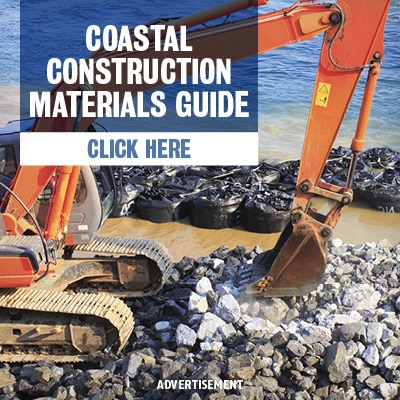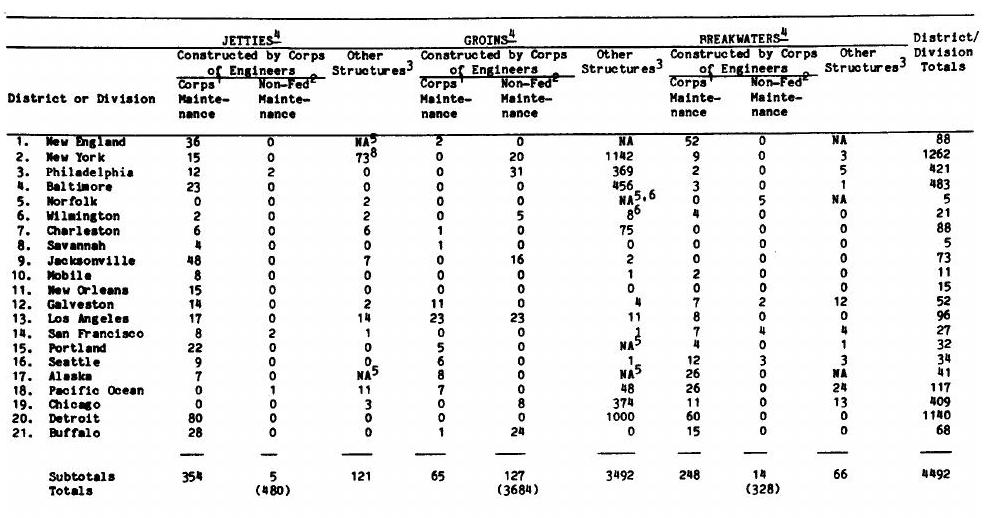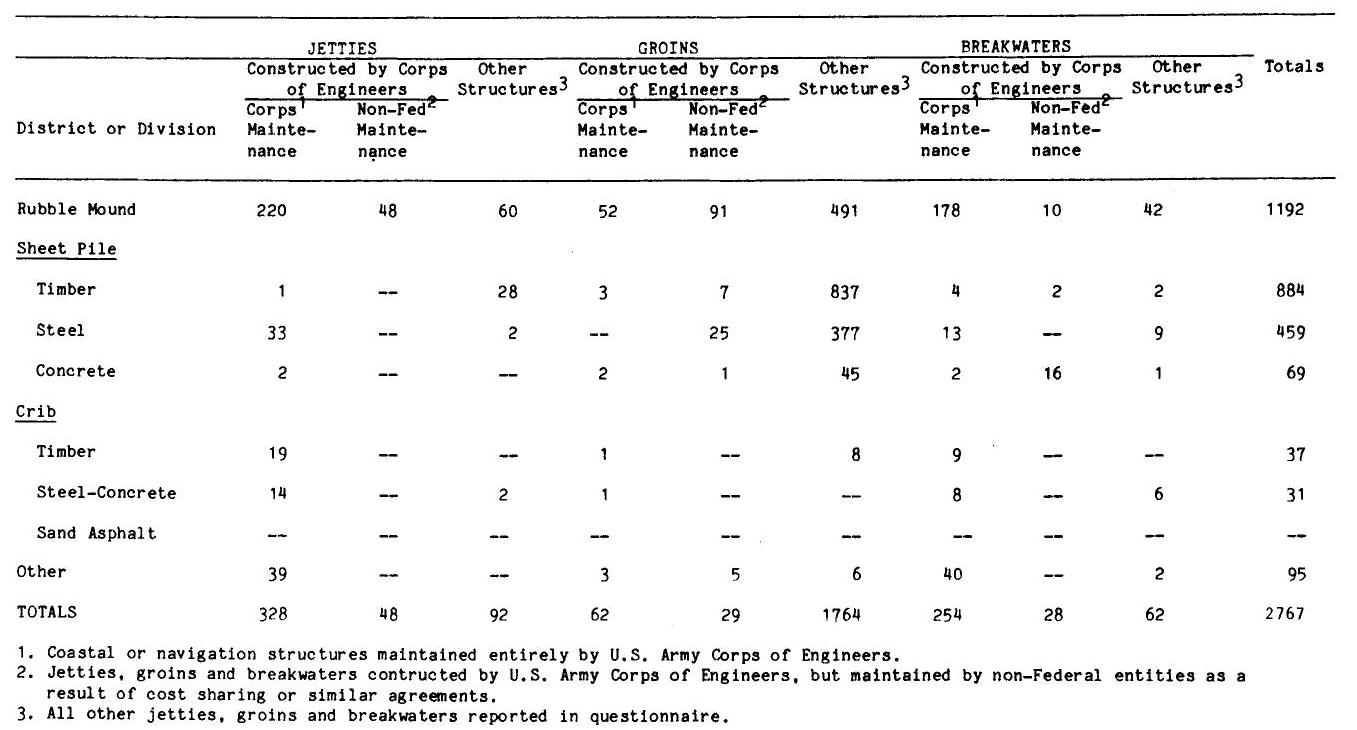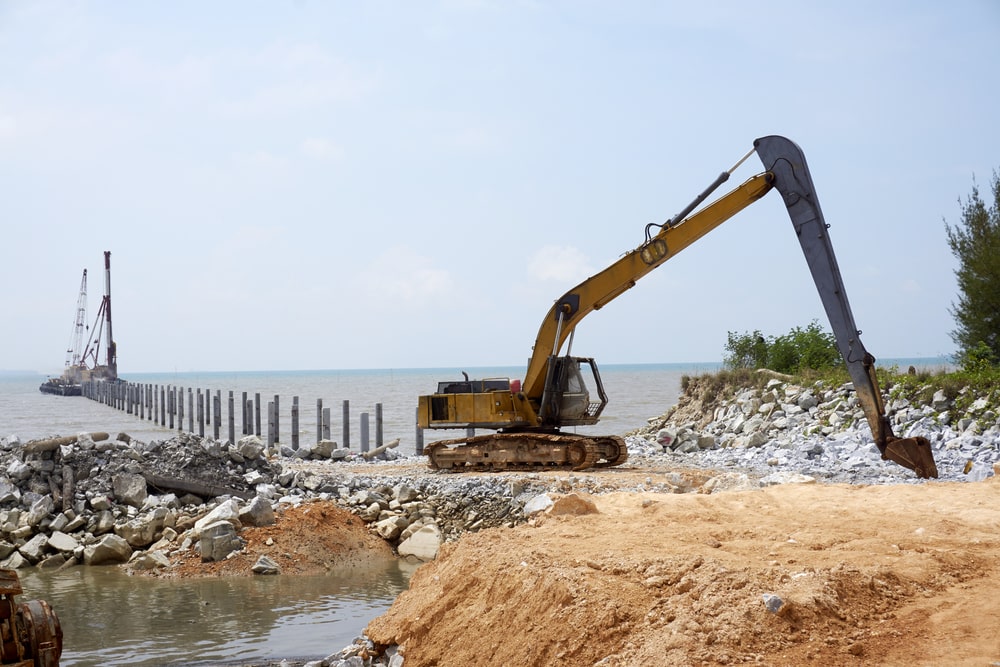Chapter 3 – Number and Type of Coastal and Navigation Structures in the U.S.
For a complete version of this document click here.
 The 21 U.S. Army Corps of Engineers districts comprising the coastal and Great Lakes regions of the United States contain approximately 11500 navigation and shore protection structures (Table 1). Based on questionnaire data provided to the U.S. Army Engineer Institute for Water Resources, it is estimated that there are 1180 jetties, 328 shore-connected breakwaters and 36811 groins in these districts. The number of existing groins in actuality may be considerably higher due to the large number of smaller structures of this sort (<20 feet), owned and maintained by private individuals and not included in district inventories.
The 21 U.S. Army Corps of Engineers districts comprising the coastal and Great Lakes regions of the United States contain approximately 11500 navigation and shore protection structures (Table 1). Based on questionnaire data provided to the U.S. Army Engineer Institute for Water Resources, it is estimated that there are 1180 jetties, 328 shore-connected breakwaters and 36811 groins in these districts. The number of existing groins in actuality may be considerably higher due to the large number of smaller structures of this sort (<20 feet), owned and maintained by private individuals and not included in district inventories.
About 711 percent of all jetties nationwide are presently maintained by the U.S. Army Corps of Engineers. Non-Federal parties (state and local governments) have constructed 121 jetties and have sole maintenance responsibilities for these structures and for five other jetties built by the Corps of Engineers. The Detroit District maintains the largest number of jetties (80), followed by the Jacksonville District with 118; New England, 36; Buffalo, 28; and Baltimore, 23. There are no Corps-maintained jetties in the Chicago and Norfolk Districts or in the Pacific Ocean Division.
Of the 192 groins constructed by the U.S. Army Corps of Engineers, a large percentage (66 percent) or 127 groins are maintained by non-Federal parties. Maintenance of such shore erosion control structures is generally a non-Federal responsibility. However, in the case of multipurpose projects providing for navigation as well as shore protection in the Galveston and Los Angeles areas, maintenance responsibility is vested in the Federal government. These districts presently provide normal maintenance and perform necessary repairs to a number of such groins, 23 and 11, respectively. Although a total of 3619 other (non-Corps and private) groins were reported, this estimate is considered rather low by Corps district personnel since it may not include the hundreds of smaller groins abutting private, residential shorefront properties.
Similar to maintenance responsibilities with jetties., the Corps of Engineers performs most of these functions on breakwaters. In 1981, this agency maintained 76 percent or 2118 structures nationwide. The New England Division with 52, and the Detroit District with 60, contained the largest number of Corps-maintained breakwaters. Other Corps offices with sizeable numbers of these structures include the Alaska District and the pacific Ocean Division, both with 26. In addition to another 111 breakwaters constructed by the Corps but maintained by non-Federal parties, there are 66 other such structures entirely built and maintained by state and local funding. Over 81 percent of these breakwaters are located in the Galveston and Chicago Districts as well as in the Pacific Ocean Division.

Type of Structure/Construction Material Utilized
Approximately 51 percent of all coastal and navigation structures in the United States were constructed using sheet pile while an estimated 43 percent contain rubble stone (Table 2). Other smaller numbers of these structures include crib-type construction (two percent) and combinations of wooden cribs with concrete caps and steel cells (four percent).
Sheet pile types include timber, steel and concrete sheet piling structures. Groins, constructed and maintained entirely without Federal funds, account for 90 percent of all coastal structures utilizing sheet piling. By far, the vast majority (over 80 percent) of all such structures are located in the New York District, the only Corps region reporting sizeable numbers of such structures. A few jetties and shore-connected breakwaters have also been constructed using a sheet piling design. A common type of sheet pile timber groins (heavily used in coastal areas around New York) is usually supported by wales and round piles. Some permeable timber groins have also been built by leaving space between the sheetings. Sheet piles are supported in a vertical position between the wales and secured to them with nails. All timber and piles used for marine construction should be given the maximum recommended pressure treatment with creosote coating.
Groins constructed of steel sheet piling (used extensively in Chicago and other Great Lakes regions) have been constructed with web and arch-web designs. Some have been made permeable by cutting openings in the piles. The interlock type of steel sheet piles provides a sand-tight connection. Steel sheet piling is also used in groin structures such as a single row of piling formation with or without buttresses, and is formed-filled with suitable material. The life expectancy of steel piling depends upon water conditions at the site.
The coastal areas around New York and Jacksonville are the only regions with any significant number of structures utilizing concrete in conjunction with sheet piling. There are 1111 such groins in the New York District constructed and maintained by non-Federal parties. The Jacksonville District contains 16 breakwaters using this type of construction material.
Rubble-mound coastal structures in the United States include 328 jetties, 6311 groins and 230 shore-connected breakwaters, or 43 percent of all structures. The popularity of this construction material for these structures is due to a variety of factors. Unlike the rigid, vertical wall type, a rubble-mound structure, when subjected to severe wave action, is not prone to complete failure. Rubble structures, not being monolithic, will follow more of a process of disintegration; that is, wearing away or dislodging stone by stone, rather than total collapse. The damaged structures, if anything, will offer a more stable base for any repairs. This repairable feature makes a decision necessary between the relative costs of initial construction and maintenance in designing a rubble-mound breakwater.

At present, 62 percent of all Corps-maintained jetties, 80 percent of the groins and 76 percent of the breakwaters have been constructed using a variety of rubble-mound construction designs. it is interesting to note that out of a total of 80 jetties maintained by the Detroit District, only six were built with rubble-mound. Costs and unavailability of suitable material may have precluded widespread usage of rubble-mound in the construction of jetties in the district.
In terms of numbers of coastal and navigation structures, lesser utilized construction design techniques and material include timber and steel concrete crib types, concrete dolosse and tetrapods. Wooden crib types are built of timber and some of the compartments are flooded. The structure is then capped with a timber superstructure which is usually replaced by concrete when the timber decays. Timber structures are not suitable for saltwater where marine borers can occur. However, in freshwater, timber crib structures give long and satisfactory service, and steel concrete cribs require little maintenance and are suitable for construction in depths up to 110 feet and in various types of sedimentary foundations. Steel concrete structures of the crib variety are vulnerable to storm damage during construction. In addition, erosion can seriously affect steel structures in water.
-
 SPW911 Sheet Pile Design Software
Rated 5.00 out of 5$150.00 – $599.99Price range: $150.00 through $599.99
SPW911 Sheet Pile Design Software
Rated 5.00 out of 5$150.00 – $599.99Price range: $150.00 through $599.99 -
 Sheet Pile Design (PDF Download)
Rated 5.00 out of 5$89.00
Sheet Pile Design (PDF Download)
Rated 5.00 out of 5$89.00 -
 Pile Driving (PDF Download)
$89.00
Pile Driving (PDF Download)
$89.00
-
 Marine Construction Volumes 1 & 2 (PDF Download)
$157.00
Marine Construction Volumes 1 & 2 (PDF Download)
$157.00
-
 Pile Driving (Book)
$89.00
Pile Driving (Book)
$89.00









